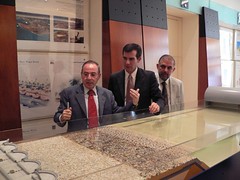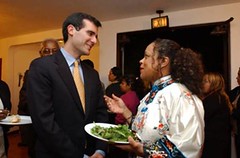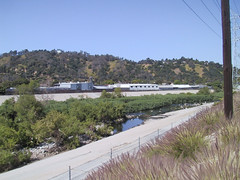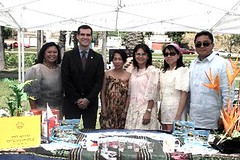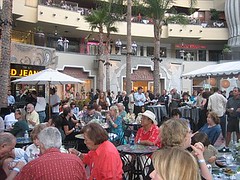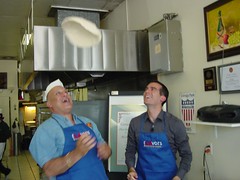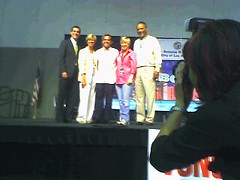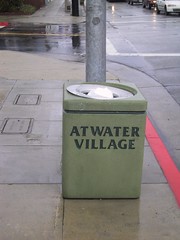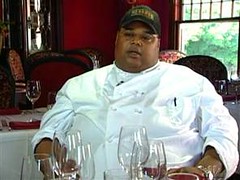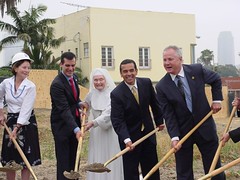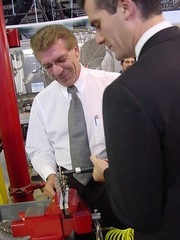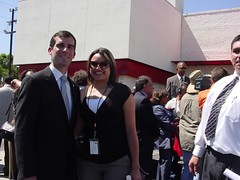Thursday, June 29, 2006
Off to Beirut!
A bustling city of over 1.5 million residents, Beirut serves as a model of diversity. Arabs, Palestinians, Kurds, and Armenians live side-by-side and converse in languages ranging from French and English to Arabic and Armenian. Councilmember Zine and I will be meeting with Lebanese Prime Minister Fouad Seniora, Minister of Interiro Ahmand Fatfat, and many other official, religious, and social leaders as we work to broaden our ties with Beirut and Lebanon in general.
The Sister City program continues to open dialogue between cities and between cultures. It provides student and professional exchange opportunities and strengthens international ties. The dynamic relationship between Beirut and Los Angeles will continue to flourish. You can track our progress on the Los Angeles-Beirut Sister City website, providing updates on news, events, and opportunities associated with the Sister City Agreement.
Posted by
lacityorgcd13
at
2:32 PM
Altagracia Perez, Presidential Appointee
Altagracia has been an invaluabe asset to Los Angeles. In the congregations she has served, she's built bridges between her African-American and Latino congregants. She's fought for justice in Inglewood, where her parish is, working with the Coalition for a Better Inglewood to rally support to defeat an initaitive placed on the ballot by Wal-Mart in 2004. She has worked extensively in urban ministry and youth work, and fought for workers' dignity and justice in the workplace through Clergy and Laity United for Economic Justice (CLUE).
Her work in the community gives her the ideal background to work on the Commission. Neighborhood councils are vital in the city’s efforts to reinvigorate Los Angeles, and as we move forward, the Reverend’s energy and enthusiasm will help to bolster support for existing councils and imbue local residents with a sense of pride and participation in the city’s renaissance.
Posted by
lacityorgcd13
at
12:24 PM
Clean Money in Mar Vista
On Monday, Councilmember Bill Rosendahl and I hosted the second in a series of Town Halls geared towards educating communities and garnering support for a clean money campaign, which would provide for public financing of the city’s elections. As I've written before in this space, clean money would take special-interest contributors out of the election process, level the playing field for new candidates, empower voters and encourage greater voter turnout, and provide a sensible approach to elections that is popular in other states and around the world. The city currently has a partial public financing system; last November I joined Councilmembers Rosendahl and Greuel in asking the Chief Legislative Analyst (CLA) to develop a proposal that would expand the scope of the program. Earlier this month, the Council received the CLA's report showing how we can realize a clean money program.
Read more...
With the report in hand, Councilmember Rosendahl and I visited Walgrove Elementary School in Council District 11 to speak with residents about the clean money initiative. We were met with great enthusiasm as we answered questions and received feedback from the community, addressing concerns and explaining what comes next. As we move towards a ballot initiative in 2007, we will be working with city departments, neighborhood councils, and community members to identify funding sources and lay out the details of the program. We will continue to hold Town Hall meetings to gather more community feedback and answer questions. Look for one in your neighborhood soon!
Our efforts coincide with a broader movement throughout California towards the establishment of a statewide clean money campaign program. The California Campaign for Clean Money is coordinating the effort to spread awareness about the issue and provide individuals from all walks of life with the opportunity to get involved in changing the nature of our democracy. They are currently in the proccess of forming a grass-roots working group that will be essential in their campaign; if you want to join, please visit their website at http://www.caclean.org/. Together we can make California a place where the model of American democracy is an everyday reality.
Posted by
lacityorgcd13
at
12:03 PM
Tuesday, June 27, 2006
"You're thinking, L.A. has a river?"
Emile Turner hosts a short video tour of the Los Angeles River at the Glendale Narrows, featuring CD13 resident and great river friend Joe Linton giving river-adjacent restaurant recommendations. And at blogging.la, Sean Bonner bikes and likes El Rio de Nuestra Señora la Reina de Los Angeles de Porciuncula.
River video via Curbed LA
Posted by
lacityorgcd13
at
5:42 PM
Monday, June 26, 2006
Guest blogger Mitch: Areas of opportunity on the Los Angeles River
Turnout was good for Saturday's River Workshop at the Goodwill Worksource Center in Lincoln Heights. The work station tables were crowded despite the fact Mexico was playing Argentina in the World Cup in a match that started at noon! By far the most action was at the "Taylor Yards" table. This site has been chosen as one of the 5 opportunity sites to be studied closely for the upcoming Master Plan. The Taylor Yard site, now expanded to include Elysian Valley and Fletcher Drive from San Fernando Road to Rowena, is one of the most important pieces of real estate in Northeast Los Angeles. It is surrounded by 3 communities within the 13th Council District; Elysian Valley, Atwater Village, and Glassell Park. CD13 residents from those communities as well as Silver Lake, and Echo Park all participated in the workshop.
Read more...In addition to my service to the district, I'm a longtime resident of Glassell Park and Northeast Los Angeles. I want to make sure building blocks are put in place that lead to habitat restoration, management and maintenance of the river environment, and pedestrian and bicycle improvements along the river at Taylor Yard and beyond. If you go out to Fletcher Drive as it crosses the River, you will see that the walking environment is hostile coming from either direction. To get to Taylor Yard From Riverside Drive, one has to walk by narrow sidewalks in front of "Girls, Girls, Girls", the adult entertainment venue. From the other direction, you either have to walk across an on-ramp to the Glendale (2) North Freeway or enter next to the DWP switching station, then head underneath the Fletcher Drive bridge where there is no pathway. Access points to the River should be the first order of business for the Master Plan.
We also need to take a hard look at quality of life along the river for people, flora and fauna. Also, businesses that have been operating along its banks need to feel secure that their concerns are being addressed. While some uses have been found to be incompatible with the river environment, we should keep in mind that many light manufacturing and other industrial uses can co-exist as they always have, albeit with a few new standards. Businesses along the River don't have to be at the expense of residents, workers, or river enthusiasts in order to thrive. It's all about continuing the transformation from a degraded, abused waterway into a revitalized, thriving natural resource that was here long before any of us were!
For comments and all other information regarding the Ad hoc River Committee, the Los Angeles River Master Plan, CD13's River Management & Maintenance task force, or River Walks, please feel free to contact me any time.
For more on the LA River Areas of Opportunity, see Steve Hymon's report in the Los Angeles Timesfrom this weekend.
Photograph by sjareb, found on flickr.
Posted by
lacityorgcd13
at
11:32 AM
Lotus Festival Luncheon
Every year, the festival offers entertainment, food, and crafts that celebrate the people and cultures of Asia and the Pacific Islands. A pageant of authentic dances, music, costumes, and food from this year’s featured culture, the Philippines, highlights the event. For the Filipino-American community, 2006 is also a very special year: it marks the 100-year anniversary of large-scale Filipino migration to the United States, which began in the early twentieth century as Hawaiian agricultural interests searched abroad for plantation labor.
The Lotus Festival also includes the annual dragon boat races, in which local non-profits and government officials take with their staffs to the high seas in fierce competition. This year we're being joined by a motley seafaring gang impressed by blogging.la. Of course, I wish all challengers good luck; you'll need it against the CD13 boat, rulers of the lake for four years in a row.
Posted by
lacityorgcd13
at
11:01 AM
Saturday, June 24, 2006
New York Times visits Hollywood
In the New York Times' Escape section, writer Cindy Price provides 36 hours of Hollywood nightlife, brunching, dining, dancing, and even horseback riding. It's a great visit, with stops at such CD13 landmarks and new spots as Los Bros Hooper's Skooby's Hot Dogs, picnicking at Cinespia in the Hollywood Forever cemetery, Thai Elvis at Palms, and George Abou-Daoud's Bowery.
One complaint: Ms. Price repeats the cliche that "nobody walks in L.A."* As you'll see when I follow up Wednesday's post about today's Great Hollywood Walkabout with a report from the field (short version: it was awesome, much thanks to CD13 Planning Director Alison Becker for turning out more than 100 urbanists, neighbors, architects and planners), Los Angeles is a city that is heavily walked, and our challenge is to make that experience easier and more rewarding.
*To the author's credit, she followed up the cliche with "...so ride a horse."
Posted by
lacityorgcd13
at
12:24 PM
Friday, June 23, 2006
Splash Bash
Posted by
lacityorgcd13
at
5:51 PM
Thursday, June 22, 2006
Ten Things Neighborhood Councils Can Do for Los Angeles
- Build power through knowledge. Bring the Government 101 curriculum to your community and teach your constituents how City Hall works. Start a Neighborhood Leadership Institute and bring some of the city wide curriculum we have developed (Planning 101, Planning 102, Planning 103, Housing 101, etc.) to your neck of the woods. These graduates will help your neighborhood have a more powerful voice throughout the city.
- Use a blog to communicate with your constituents. Every community has people who serve as information hubs, who follow new development projects and who know the local goings-on. Recruit them as bloggers for your neighborhood council. People get involved and stay engaged when they can find regularly-updated information about the community. In Echo Park, where I live, the revitalized Echo Park Net is a great example.
- Welcome new residents to your neighborhood and get them involved. Welcome-packs are a great way to introduce new residents to your neighborhood. Work with all of the local realtors in your neighborhood council area to put together critical information and useful tips, including how to access city services, a guide to local businesses, and your council’s Neighborhood Emergency Operations Plan (see number 9 below).
- Empower young people in your community. If you do not already have a youth representative on your neighborhood council, get one! Adopt a local school and work with the social studies or leadership teachers to help identify or elect a student representative on your council.
- House Los Angeles. The housing crisis in Los Angeles is the worst in almost sixty years. Less than 10% of Angelenos can qualify for a mortgage on the average-priced home in Los Angeles. Consider endorsing the principles of a $1 billion housing bond for the ballot in Fall 2006. Visit www.homesforlafamilies.org for more information.
- Clean up your neighborhood. Bring UNTAG (Uniting Neighbors To Abolish Graffiti) to your neighborhood. This initiative reduced graffiti by 62% in a single year in CD13 and can work in your neighborhood, too. We recently expanded this program to go citywide, and all we are waiting for is you. Visit http://www.lacity.org/council/cd13/untag.htm for more information.
- Clean up your city. Los Angeles has the country’s dirtiest air and water. We consume disproportionate amounts of resources and contribute to global warming. Assess your own neighborhood by measuring your environmental footprint at http://www.myfootprint.org and see what you can do to reduce your footprint. Work with the Bureau of Sanitation to see if your neighborhood might be ripe for a project to clean your neighborhood’s water through Proposition O. You can clean the water and beautify your neighborhood at the same time.
- Clean up your government. Join the Clean Money Campaign to take special interest money out of politics. By implementing a full public financing system for municipal elections, Los Angeles can join other states and cities around the country that are returning democracy back to our communities. For more information, visit www.calclean.org.
- Prepare for emergencies. Prepare a Neighborhood Emergency Operations Plan. Neighborhood Councils will be on the front lines of responding to any emergency situations in the city or in their communities. Work with the Emergency Operations Department and DONE to develop a 21st-century phone tree to help communicate with your constituents during an emergency. Be prepared!
- Make policy. Help get final passage of the proposal to trigger the opening of council files when a critical number of neighborhood councils weigh in on policy proposals. This will help open a new chapter in neighborhood empowerment and build on many of the policy successes initiated by neighborhood councils, from cable policy to water rates.
Posted by
lacityorgcd13
at
6:03 PM
Wednesday, June 21, 2006
Hybrid program extended
With a unanimous vote from my colleagues, a program that I initiated two years ago had its lifetime extended today. Drivers of clean air vehicles like hybrids and electric cars will continue to enjoy free metered parking. The program remains in effect until 2008, when we'll have the opportunity to renew it again.
To participate in the program, you must display a California Department of Motor Vehicles Clean Air Vehicle decal. Also, keep in mind that while you don't need to fish under your seat for loose change at the meters anymore, you still have to obey posted time limits and preferential parking restrictions.
Also, tell your friends about the program—both those who are already driving hybrids and those who are thinking about buying one. With gas prices climbing, you may not even need this perk to decide that it's time to reduce your reliance on "the dinosaur" (that is, petroleum fuel). But my office has heard from several people who, once they heard about the parking privilege, decided the time was right for them to go hybrid. And the basin's air is better for it.
Posted by
lacityorgcd13
at
3:34 PM
This Saturday: Come Join the Great Hollywood Walkabout!
Does the word 'Hollywood' make you think of not just a cool sign but a real neighborhood as well? Do you like to imagine spending an entire day in the city you live in without using your car? Do you own a comfortable pair of shoes?
If any of those are true, let me invite you to join architects, planners, and your neighbors for a fun morning walk this Saturday, June 24, to discover just how fabulous the streets of Hollywood are or can be.
More below the jump.
Read more...
8:30 AM - 9:00 AM Refreshments and Registration
9:00 AM - 10:30 AM Presentation of Great Streets Principles and Walk Audit Training
10:30 AM - 12:30 PM Walkabouts on the Streets of Greater Hollywood
Location: Council District #13 Field Office
5500 Hollywood Boulevard, 4th Floor
(Southwest Corner of Hollywood Blvd. and Western Avenue, across the street from the Metro Red Line Hollywood/Western Station)
Presentation and Training by Deborah Murphy, Urban Design + Planning and Los Angeles Walks
Participants will train, divide into groups, and wander the streets of Hollywood paying close attention and asking these questions of their environment:
What makes a great street?
Do the streets of Hollywood have what it takes to be great streets?
Does the street have a strong image and sense of place? Is there a sense of enclosure and human scale, interesting places to walk by and visit and easy pedestrian access to shops?
Wear comfortable walking shoes, a hat and sun protection. Water will be provided
For further information or to sign up please contact Jane Berner in CD13 at 213.473.7013 or via email at jane.berner@lacity.org
Posted by
lacityorgcd13
at
3:30 PM
Thursday, June 15, 2006
A Safer L.A. River
The river now features mile markers that can be used as addresses along the river; these, combined with regular river bicycle patrols, help citizens and police prevent crime and make the river safe for recreation.
Northeast Division sends a bicycle team to patrol the river six days a week; they cover territory between Los Feliz Boulevard and the 110 Freeway. Since March, they have made ten felony arrests and twenty misdemeanor arrests.
The mile markers will help facilitate responses by LAPD and the Fire Department to emergency calls from citizens along the river. The river markers feature a blue heron and appear every tenth-mile between Fletcher Boulevard and Los Feliz Boulevard. They were initiated by a council motion that Ed Reyes and I wrote together, and eventually they will run all the way to the river’s Long Beach end.
Posted by
lacityorgcd13
at
4:00 PM
Friday, June 09, 2006
What's going on in Atwater Village?
In response to some mumblings and rumblings—bumblings? somethings—over at Curbed LA, I thought I'd send Atwater Villagers home for the weekend with a short update on some of the work CD13 has been doing in that community.
First question: why do asphalt streets have more repair work done than concrete streets, and why have some streets been paved more than once in recent memory? (I'm paraphrasing.)
The recent "repaving" that the curbed.la reader saw was actually a slurry-seal treatment, not a full repaving. The existing streets got a thin layer of petroleum "slurry". This extends the life of the street by an average of 7 additional years, delaying the need for a full, expensive repaving.
Concrete streets are more difficult. Since it's pretty much cost-prohibitive to repair them to their original state, the Bureau of Street Services (BOSS) prefers to fix them by paving them over with asphalt—which many residents, fond of the concrete streets, object to. Federal and state dollars that could be used for concrete street repair become available annually, but there is heavy competition between worthy neighborhood projects for those funds.
Second question: Why are we doing temporary street sweeping on certain blocks of Atwater Village when we could just add a few signs and have regular street sweeping?
Sadly, I can't add city services simply by placing a sign on a street. The addition of new blocks to the street-sweeping route requires an allocation from resources that are already very scarce. The writer mentions a temporary program, probably the one we conducted between Atwater Street and Silver Lake Boulevard. We were able to persuade the BOSS to extend the six-month program for a second six months, but they had to end it after the first renewal. I continue to keep an eye out for new funds that could address this problem.
There's more to Atwater Village than street cleaning and slurry sealing, though! Here's a short taste of some of our recent and ongoing work in the neighborhood:
- At Chevy Chase Park and by the Red Car River Park, we've found funds to raise the wattage on the lights and install security cameras that will be monitored by the LAPD. These cameras have been very successful at preventing crime elsewhere in CD13 and throughoutthe city.
- My office is assisting the nascent Fletcher Drive Business Watch by producing new Business Watch District signage, complete with LA Municipal Code citations.
- You may have already seen the recently completed lighting improvements in South Atwater Village, not to mention the long-awaited Glendale Bouelvard streetscape project
Posted by
lacityorgcd13
at
4:09 PM
Terry Fortia on MSNBC
Posted by
lacityorgcd13
at
12:10 PM
Good Shepherd Groundbreaking
Posted by
lacityorgcd13
at
12:07 PM
Airbus and aerospace jobs
I took a trip down to Monogram Aerospace Fasteners in Commerce, CA, where I was joined by Jeff Henry and Keith Brunell from Monogram as well as Commerce Mayor Nancy Ramos, my fellow Councilmember Wendy Greuel, Ron Gastelum from the Greater Los Angeles Chamber of Commerce, Allan McArtor from Airbus North America, and Fred Freuh from UAW local 650. For some more pictures of the factory tour, check out my flickr page.
While Hollywood only just cracked the top ten industries of our local economy recently, aerospace was a linchpin of Southern California’s middle class for decades.
It's no longer the juggernaut it was—no American manufacturing subsector is—but surprisingly, it continues to be a prominent player in our economy today. It’s not true that the days of aerospace are gone; what’s true is that the days of our region being defined by one or two single industries are over.
The strongest quality of our economy is its variation. We’re no longer subject to the kind of shock we felt when national economic shifts pushed out manufacturing. The thousands of aerospace jobs in los angeles today, bolstered by continued investment from global players like airbus, are higher-skilled jobs that pay about 25% higher in inflation-adjusted dollars than the jobs of twenty years ago.
The risk we have is that our region must step up to educate and train the young workers to take these jobs. Los Angeles—am I starting to sound like a broken record?—doesn’t have a jobs gap. We have a skills gap. Whether through Hire L.A. or by cultivating relationships with international manufacturers, we must commit ourselves to developing the educational and training infrastructure to help our young people take advantage of what are still middle-class manufacturing jobs.
Oh, by the way, I did get to fabricate a set of fasteners (see pic). And you can fly with peace of mind this summer: I kept them as a paperweight.
Posted by
lacityorgcd13
at
11:53 AM
Thursday, June 08, 2006
Summer Jobs
The choice is for more than any individual young person who may not see how important job skills and a good education are to his or her future. It’s to the future of our economy. Los Angeles is not facing a jobs gap. We face a skills gap. Employers seeking to fill high-skilled positions can’t get what they need out of our local workforce because our city has let them down.
This summer, let’s start making it up to them. The Mayor and Council have put together Hire L.A. to start connecting young people with opportunities for employment. (The woman in the picture, Monica Gonzalez, got her start in a similar program.) The main program components are:
- Learn and Earn, which will set up 1400 at-risk students with classes in the morning and a job in the afternoon
- the Summer Youth Employment Program, which young people can enter via their local WorkSource center or other community-based organizations
- Los Angeles Public Works, which has slots in its recycling program for sixty young workers, also hired via Worksource centers
- LA Cityworks, which offers entry-level civil service opportunities to young adults
- Hire LA 18-24, which calls upon the private sector to provide employment opportunities for 1000 18- to 24-year-olds
Posted by
lacityorgcd13
at
4:41 PM
Tuesday, June 06, 2006
Green roofs in Los Angeles
Tomorrow, I'll be co-hosting the Green Roof Market Symposium with Green Roofs for Healthy Cities and the Los Angeles Department of Water and Power. The Green Roof phenomenon answers the question "What if we could take all that space on top of our buildings and put it to work for our environment?"
Green roofs are an important component of green building, a movement that can do more to clean up our environment than any other single change in our habits (40% of the material in landfills is from construction waste). Green roofs reduce energy consumption, mitigate urban heat island effect, filter air pollutants, and clean storm water. They also provide natural habitat for birds and green space for recreational enjoyment. Green roofs have now been recognized under the United States Green Building Council’s (USGBC) Leadership in Energy and Environmental Design (LEED) accreditation program. Now we've got to figure out how to make green roofs work for our environment and for our water conservation needs.
All the information about the conference can be found here. I'll address the conference, as will Councilmember Ed Reyes, Environmental Affairs Department General Manager Dee Allen, and Commissioner Mary Nichols of the Department of Water and Power. If you're a designer, planner, developer or landscape architect, or even just thinking creatively about the design of your own home, I'd love to talk to you there. If you can't make it by but you'd like to learn more about green roofs, my legislative deputy and environmental maven Molly Rysman has more information.
Posted by
lacityorgcd13
at
4:05 PM

